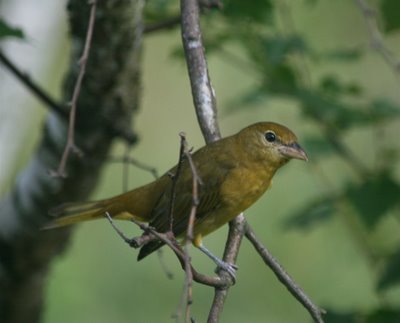 I photographed this bird, virtually convinced that it was a summer tanager. All the marks were there. Large paleish bill, low-contrast wings, warm ochre-green-yellow coloration, longish tail. I truly thought it was a summer tanager until I examined the photos, and until I saw what might have been the same bird the next evening. Bill and I had a lively exchange about it. "Oh! there's that summer tanager that's been hanging around the Spa!" I said. "That looks like a scarlet to me," Bill commented. Being a chimp, I went one by one through the ID characters that I thought added up to summer tanager. He wasn't impressed. It seemed like an impasse. And then the bird sang, sitting up in the bare branches of a dead tree. It was a scarlet tanager's song.
I photographed this bird, virtually convinced that it was a summer tanager. All the marks were there. Large paleish bill, low-contrast wings, warm ochre-green-yellow coloration, longish tail. I truly thought it was a summer tanager until I examined the photos, and until I saw what might have been the same bird the next evening. Bill and I had a lively exchange about it. "Oh! there's that summer tanager that's been hanging around the Spa!" I said. "That looks like a scarlet to me," Bill commented. Being a chimp, I went one by one through the ID characters that I thought added up to summer tanager. He wasn't impressed. It seemed like an impasse. And then the bird sang, sitting up in the bare branches of a dead tree. It was a scarlet tanager's song.So I looked at these photos with a fresh eye, and realized that, while it bears a certain resemblance to a summer tanager, this bird lacks the oversized and rather homely yellow beak, the long tail and undertail coverts, the rich coloration, and the large size of a summer tanager. But look how big that bill looks when the bird's head is sleeked all the way down!
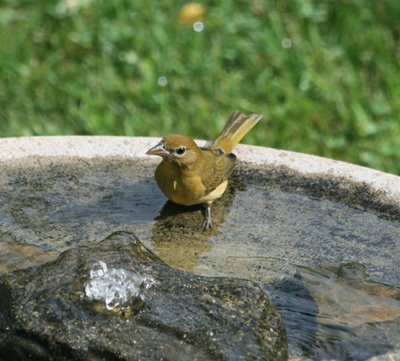
From a field mark standpoint, this bird is pretty confusing. Scarlet tanagers are supposed to have blackish wings, which contrast with a pale body. Summer tanagers have very little contrast in wing to body. Like this bird. Or like a fresh juvenile scarlet tanager.
Scarlet tanagers are supposed to have darkish beaks, not yellowish, and the beak should be much more delicate than a summer tanager's. This one has a dark culmen, but the mandible is pale. Again, this is a function of its youth.
He contemplates his own identity. Darn it, I'm still not dead sure. But I can tell you that all the photos in this post depict the same individual.
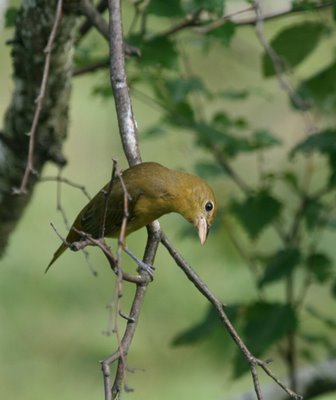 Bathes with an immature indigo bunting.
Bathes with an immature indigo bunting.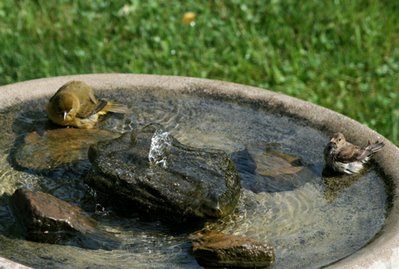
It just goes to show you that it's easy to misidentify a bird, and uncertainty can be waiting right around the corner. It helps to have multiple observations, multiple observers, and it really helps when the bird opens that indeterminately sized-and-colored bill and sings!
It really looks like a scarlet from this angle:
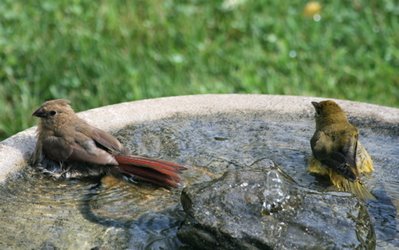 I'm convinced that birds enjoy bathing together. One splashing about brings others from far and near. It's so cute...the bather gets going, and birds come to the nearby birch and fluff their plumage, and you can see them thinking, "Man! That looks like fun!" The next thing you know they're in the tub. This young cardinal was geeking out, thinking she was bathing with a celebrity. Allow me to splash you.
I'm convinced that birds enjoy bathing together. One splashing about brings others from far and near. It's so cute...the bather gets going, and birds come to the nearby birch and fluff their plumage, and you can see them thinking, "Man! That looks like fun!" The next thing you know they're in the tub. This young cardinal was geeking out, thinking she was bathing with a celebrity. Allow me to splash you.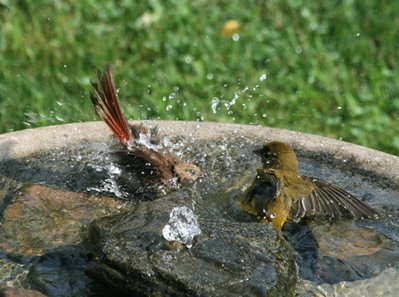






1 comments:
Julie, I am so hooked on your exploits... I am sure you don't remember a post/question from me a few months back trying to ID a "olive-colored" bird in my front yard, but DANG! I think this is it! Often seen in my back yard which abuts a large forested area, and kind of largish...anyway, thanks for all the great advice. Watching the bluebirds in the front yard eat some meal worms we put out.
Thanks again,
Lauren Vickerman
Pawcatuck, CT
Post a Comment